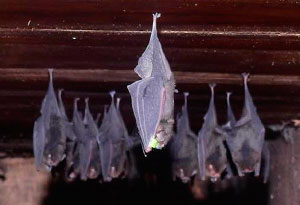
Furipterus-horrens-SVL
Selva Verde's Thumbless Bats: Update
In 2017, an extraordinary discovery was made at Selva Verde: more than 44 years after the species was last documented anywhere in the country, a colony of thumbless bats (Furipterus horrens) was observed roosting under one of the lodge’s bungalows by staff member and naturalist Henry Alfaro-Lara. Alfaro, who has studied and worked with bats for approximately 12 years, continues to monitor this population, adding to science’s understanding of the thumbless bat’s ecology.
For a look at Selva Verde’s bat diversity, this short video with Alfaro and naturalist guide Melany Ocón highlights some of the different bat species that can be found in the Sarapiquí region, including the common vampire bat, the greater sac-winged bat, and of course, the thumbless bat. Of the country’s 110 or so species, 24 have been recorded at Selva Verde. Bats make up more than half of Costa Rica’s terrestrial biodiversity and play an important role in seed dispersal, plant pollination, and pest control.
This past May, Alfaro and other researchers gathered at Selva Verde to collect data on the bats’ reproductive patterns, including gestation period, parturition, and offspring. On the first day, researchers recorded one specimen at Bungalow #5 and a colony of around 60 individuals, including three females with their respective offspring, at Bungalow #3. In addition, they recorded some juveniles in flight. On the second monitoring day, at approximately 8:25 am, researchers noted the colony was quite active. Upon entering to count and collect data, they recorded five specimens at Bungalow #4, including three females with offspring, and a fairly large group of more than 50 specimens at Bungalow #3.
Interestingly, the researchers also observed another type of bat, the common big-eared bat (Micronycteris microtis), residing within the F. horrens colony. They recorded approximately seven individuals, including females with offspring.
Selva Verde is honored to host this ongoing research and recognizes the important contributions of those who support the projects, including our naturalist guides and other volunteers. We continue to make efforts to protect the colony, and we’re excited to confirm that this important species not only continues to reside on the property, but that its population is increasing.
